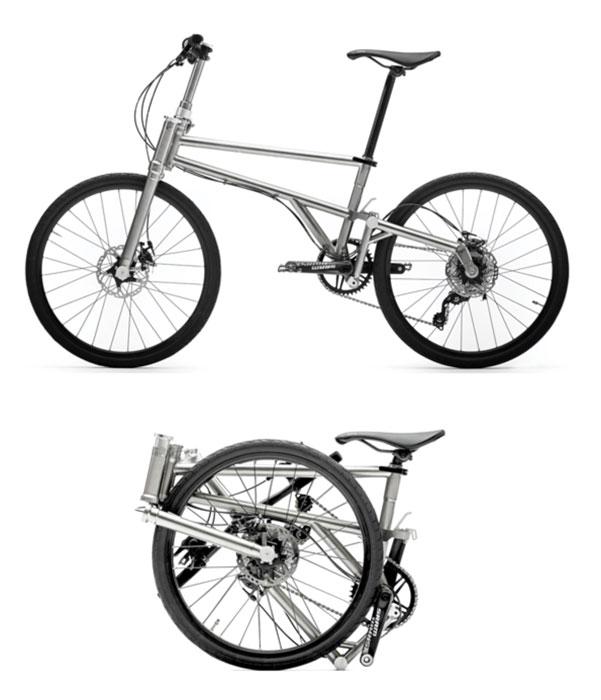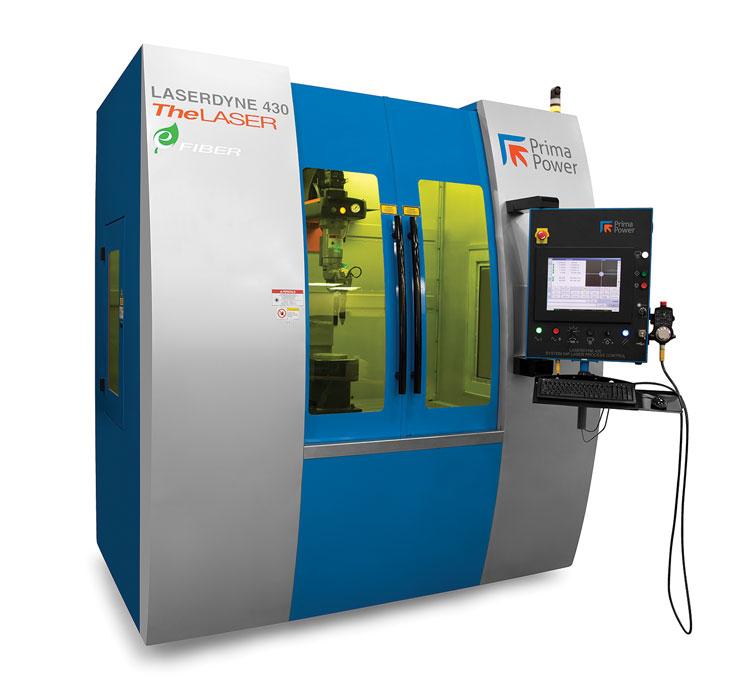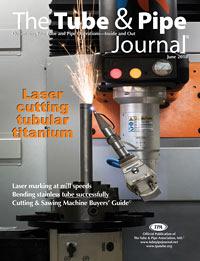- FMA
- The Fabricator
- FABTECH
- Canadian Metalworking
Categories
- Additive Manufacturing
- Aluminum Welding
- Arc Welding
- Assembly and Joining
- Automation and Robotics
- Bending and Forming
- Consumables
- Cutting and Weld Prep
- Electric Vehicles
- En Español
- Finishing
- Hydroforming
- Laser Cutting
- Laser Welding
- Machining
- Manufacturing Software
- Materials Handling
- Metals/Materials
- Oxyfuel Cutting
- Plasma Cutting
- Power Tools
- Punching and Other Holemaking
- Roll Forming
- Safety
- Sawing
- Shearing
- Shop Management
- Testing and Measuring
- Tube and Pipe Fabrication
- Tube and Pipe Production
- Waterjet Cutting
Industry Directory
Webcasts
Podcasts
FAB 40
Advertise
Subscribe
Account Login
Search
Folding bicycle manufacturer uses laser cutting for titanium frame components
- By Eric Lundin
- May 17, 2018
- Article
- Laser Cutting

Although folding bicycles were first devised around 1900, Peter Boutakis is undaunted by this long history, founding Helix Labs to develop “the best folding bike on the planet.” The Helix side-by-side folding design puts the wheels beside the frame and between the cranks for storage efficiency and uses titanium for durability.
Markets divide. Always. Every inventor who has ever devised a new product knows, or learns, that it’s just a matter of time before a similar product comes along and challenges the incumbent. Even something as simple as a hammer is available in many sizes and styles—claw, sledge, ball peen, and so on.
So it is with the bicycle. The earliest version, developed in 1817, was a simple contraption without pedals, sprockets, or a chain. Named Laufmaschine (literally, running machine) by its inventor, Karl Drais, it was propelled by a running motion. The tricky-to-ride high-wheeler came to prominence in the 1870s, and that was replaced in 1885 by a new concept, one initially marketed as the safety bicycle. Outfitted with two wheels of the same size, powered by sprocket-mounted pedals, and driven by a chain that engages a gear on the rear wheel, the design elements haven’t changed much since then.
This doesn’t mean that the market hasn’t continued to divide. Indeed, it has. Riders today can choose bicycles for sport or leisure in various styles: mountain, road, hybrid, cruiser, recumbent, tandem, electric, and folding.
Many apartment dwellers prefer folding-style bicycles for their compact size, and many serious riders often stow a bicycle in the trunk of a car and set out to find a good place to ride.
This market niche is noteworthy for the engineering and fabricating challenges. Designing a bike to fold up is no mean feat; designing one that folds up and rides well is more difficult still. It’s a matter of balancing three constraints: rideability, weight, and the size when folded. Entrepreneur, machinist, welder, CNC programmer, software developer, and cycling enthusiast Peter Boutakis figured he had something to contribute to the folding bicycle market when he founded manufacturing company Helix Labs Inc. in Toronto to chase an ambitious goal: To design and manufacture the best folding bicycle on the market.
He hasn’t looked back.
The Folding Market Unfolds
The folding concept isn’t new. The earliest folding design was based on military interest in using bicycles for transportation, which arose around 1890, and in 1941 the British War Office solicited bids for a folding bicycle to be delivered by parachute. Even then the folding bicycle market was becoming specialized.
These days, manufacturers use several folding strategies. One concept, the half-fold, uses a frame that folds in half horizontally so that the front end of the bicycle swings nearly 180 degrees; when folded, the front and rear wheels sit side by side. This is likely how the earliest folding cycles folded. Another approach uses vertical folding, which is more complex. The front section folds under, rearward, and the rear section folds under frontward, resulting in a more compact profile than many half-fold bicycles have. Other designs use variations on these themes (for a thorough discussion, see www.foldingcyclist.com).
You Can’t Get There from Here
While nobody would expect a folding bicycle to be the equivalent of a standard bicycle, folding designs have always sought to minimize the differences. Some manufacturers use small wheels to achieve a compact folded size, sacrificing some riding stability and comfort. Some use beefy hinges and heavy-duty components, making a sturdy, robust bicycle that is quite a bit heavier than its non-folding counterparts.
Another concern is safety. A folding bicycle is made to fold up, so if the clamps aren’t secure, it might fold up at the wrong time.

Figure 1
In addition to its compact size, the model 430 Beam Director has a few proprietary features that enhance production, including several levels of crash protection, part surface mapping, Automatic Focus Control™, a CCTV process monitor, and statistical process control data acquisition.
Size is another point. A bicycle made for the youth market is not nearly as large as an adult bicycle, so a youth-market folder can be extremely compact when folded. An adult bicycle has a large frame and large wheels, so developing an adult-size folder that collapses to a convenient size for carrying or stowing is a big challenge.
Maybe You Can Get There from Here
As a university student in the 1990s, Boutakis enrolled in a computer science program, but it wasn’t quite what he was looking for. He shopped around for a different curriculum, and after enrolling in a few CNC programming courses, he realized that he had found his niche. That niche was manufacturing.
He bought a small, four-axis mill and built up a small but capable shop, equipping it with a lathe, gas metal arc welding and gas tungsten arc welding equipment, a couple of saws, and a variety of hand tools. He worked as a machinist, a welder, and a fabricator for about a decade, accumulating a wealth of experience along the way.
“It provided a solid foundation in three main areas—machining, welding, and fabrication,” Boutakis said.
He didn’t abandon computer science entirely. In fact, this background helped in another endeavor, one in which he worked as a freelancer developing web-based applications for a variety of clients. This provided some additional income that augmented his shop work.
Juggling these two vocations wasn’t enough. A cycling enthusiast and an entrepreneur at heart, he gave a lot of thought to the folding bicycles on the market, and figured he could develop a better way to make one. Boutakis’ goal was to reduce the compromises in a folding bicycle by developing one that would be safer, easier to use, lighter in weight, and more compact when folded than any folder on the market.
First, the size. Helix models fold down to the size of the wheels, approximately, which are about 24 inches in diameter, depending on the tire. The folded Helix size, 23 by 26 by 9.5 in., is accomplished by a design that uses a side-by-side folding concept. It puts the wheels beside the frame and between the cranks, which the company claims to be the most efficient use of space.
Second is safety. According to Boutakis, the locking mechanisms on most folding bicycles are a source of concern for three reasons. First, they require scheduled maintenance and routine observation to ensure they are working correctly. Second, they clamp at a single point on the tube’s circumference, so they usually allow a bit of play. Third, the combination of play and elevated stresses at the weld can lead to clamp failure.
Helix uses proprietary, patent-pending, spring-loaded locking mechanisms that pass through the fork and steerer tubes, which Boutakis says is a safer locking device than many of the others on the market. They are designed to develop substantial force, optimizing clamping tension, which actually increases under the stresses of riding. The clamps also distribute the clamping force over a much larger surface area so that there are no stress peaks, making them far less likely to fail catastrophically. They expand in all directions, creating a rigidity throughout 360 degrees, which eliminates play. Also, the Helix design uses a built-in safeguard: the design uses a tube inside a tube, so if the spring actuator fails during a ride, the bike doesn’t fold up.
Third is ease of use, which concerns the side-by-side folding concept and patent-pending helical hinges. They allow the rider to fold the three elements—rear wheel, front wheel, and handlebar—in any order. No need to memorize the order to stow it.

Figure 2
Helix Labs uses its 430BD system with additional rotary table for mounting tube horizontally. The rotary table features a through-bore chuck to locate the titanium tubes accurately and hold them firmly for locating the bevels, holes, and slots precisely.
Fourth is the bicycle’s weight. The company uses grade 9 titanium (3Al, 2.5V), cold-worked and stress relieved, for the frame components. The darling alloy of the space age, titanium is instrumental in helping aerospace engineers develop advanced aircraft and spacecraft that can withstand the stresses of take-offs, landing, and launches. Inherently robust, lightweight, and corrosion-resistant, these characteristics make it well-suited for building bicycles, too.
Fabricating Ti
At the outset, Boutakis knew that assembling bicycle frames made from titanium would be anything but easy. It’s not an uncommon material, but then again, not everyone is well-versed in fabricating this relatively pricey, niche material. Some research on his own part and some assistance from others in the industry helped Boutakis accumulate enough understanding of titanium to develop a reliable, consistent fabrication process.
Welding It. Welding titanium needs an inert atmosphere, and the process relies on a stringent purging and postweld protocol. For a bicycle, using purge dams to protect the inside diameter (ID) and welding cups for gas coverage on the outside diameter would add significant challenges to the welding process. Small clearances and curved surfaces, especially where two curved surfaces meet—which is the essence of making a bicycle frame—compound the challenges in making robust welds.
Eventually Boutakis decided that the welding would be done robotically. Favored for process consistency and a steady pace, robotic welding units work meticulously, from one weld to the next, all day long. Human welders have slight differences in technique and are prone to fatigue, distractions, and other factors that can introduce inconsistencies. This doesn’t mean that their welds are substandard quality, but they are prone to variances in their characteristics, which means that weld strength can vary, whereas a robot is immune to these dynamics.
However, integrating a robot can test the patience of even a veteran manufacturer.
“I couldn’t find the right torch,” Boutakis said. “The problem is that the joints don’t provide much in the way of clearance. This is basically a micro-TIG application, working in a very small area, and only a few such torches are available for robots.” Ever the inventor, he ended up developing his own torch, one with a wire feeder, for his application.
To get around the time and hassle involved in protecting the weld area from oxygen, Boutakis created a large purge chamber, one that houses the robot and the custom fixturing needed for the tubing.
“It’s basically a really large glove box,” he said. It’s equipped with an airlock system so he can get raw materials in and finished frames out without contaminating the atmosphere.
“I’m sure it’s the only one of its kind in the bicycle industry,” he said.
Cutting It. The big drawback in using a welding robot is that it can’t self-adjust to compensate for variations in weld preparation. When a bevel is slightly off or a gap isn’t quite right—too wide, too narrow, or inconsistent—a robot plods along, welding according to its programmed instructions. A robotic welding unit makes each joint based on an ideal situation, unable to make any changes to its routine for less-than-ideal fitup.

Figure 3
Helix bicycle components require many sophisticated cuts, including a variety of steep bevel angles. The engineering staff of Prima Power Laserdyne delivered a fiber laser cutting machine, and divulged titanium-cutting expertise, so that the cutting process provides an edge finish that allows the parts to mate perfectly without deburring.
This meant that Boutakis had one more decision to make, perhaps the most critical one of the entire operation. He needed rock-solid consistency in cut length and bevel angles, and the process had to be fast. The system would have to make fairly steep bevel cuts, up to 45 degrees, and Boutakis wanted a system that would leave clean edges that wouldn’t require subsequent deburring. The tubes would go from cutting to welding without any intermediate steps, such as material handling and deburring, which would require more equipment, more processing time, and more floor space.
Laser cutting was an option, but with a caveat.
“Lasers make spatter,” Boutakis said. He didn’t know how he would get around that problem, but in the end, he didn’t need to. In weighing various options, he found a laser that he thought would be suitable for his company. That machine is model 430 Beam Director®, a fiber laser unit made by Prima Power Laserdyne.
Equipped with a massive worktable for mounting custom workholding fixtures, it provides the stability necessary for applications that need tight dimensional tolerances, such as aerospace, medical, and electronics. The X, Y, and Z axes achieve a part tolerance of ±12.5 µm.
Equipped with the third generation of the company’s Beam Director, which provides two axes of laser beam motion without part movement, the machine is capable of both cutting and welding. The machine manipulates the part’s position with six axes of control, and while it’s small enough to be suitable for prototyping, access from the front and both sides make it useful for production, too (see Figure 1).
Prima’s engineers brought more than a machine. They brought a willingness to work with Boutakis to develop a process that would work for his needs. A key system feature is a horizontally mounted rotary table with a through-bore chuck that holds the tubes firmly so that bevels, holes, and slots are located accurately (see Figure 2).
They also brought titanium expertise to the table. The problem of spatter and dross already had been solved (see Figure 3). Boutakis was pleased to learn that it was simply a matter of applying a boron nitride spray to the tube’s ID, then inserting a sacrificial mandrel.
Is this the system he uses? Well, of course not. Boutakis is an innovator.
“I found that spraying the ID was tedious, so I developed my own variation on the practice,” he said.
Stow and Go!
Although folders aren’t for everyone, the Helix design can accommodate nearly any rider. The design is versatile enough that it fits riders from 5 ft. to 6 ft. 4 in.
The seat post has a 20-millimeter setback that can be reversed to achieve a 20-mm forward position, and the handlebar stem likewise is adjustable. It rises 20 mm and it can be flipped so it drops 20 mm. If any of these adjustments are not enough, the key components—stem, seat post, handlebar, and crank arms—can be replaced with off-the-shelf components of other dimensions.
It comes with several gear options for various riding styles: a single speed, 10-speed derailleur, or an 11-speed internal gear hub.
It even accommodates a variety of enthusiasm levels. Some ultraserious riders need bicycles that can be stowed on an airplane so they can travel to a distant place with good trails or an interesting competition. This is a folder for this caliber of rider, because it’s small enough to fit into a suitcase.
Helix Labs Inc., www.helix.ca
Prima Power Laserdyne, www.primapowerlaserdyne.com
About the Author

Eric Lundin
2135 Point Blvd
Elgin, IL 60123
815-227-8262
Eric Lundin worked on The Tube & Pipe Journal from 2000 to 2022.
About the Publication
Related Companies
subscribe now

The Tube and Pipe Journal became the first magazine dedicated to serving the metal tube and pipe industry in 1990. Today, it remains the only North American publication devoted to this industry, and it has become the most trusted source of information for tube and pipe professionals.
start your free subscription- Stay connected from anywhere

Easily access valuable industry resources now with full access to the digital edition of The Fabricator.

Easily access valuable industry resources now with full access to the digital edition of The Welder.

Easily access valuable industry resources now with full access to the digital edition of The Tube and Pipe Journal.
- Podcasting
- Podcast:
- The Fabricator Podcast
- Published:
- 04/16/2024
- Running Time:
- 63:29
In this episode of The Fabricator Podcast, Caleb Chamberlain, co-founder and CEO of OSH Cut, discusses his company’s...
- Trending Articles
Team Industries names director of advanced technology and manufacturing

Orbital tube welding webinar to be held April 23

Push-feeding saw station cuts nonferrous metals

Corrosion-inhibiting coating can be peeled off after use

3D laser tube cutting system available in 3, 4, or 5 kW

- Industry Events
16th Annual Safety Conference
- April 30 - May 1, 2024
- Elgin,
Pipe and Tube Conference
- May 21 - 22, 2024
- Omaha, NE
World-Class Roll Forming Workshop
- June 5 - 6, 2024
- Louisville, KY
Advanced Laser Application Workshop
- June 25 - 27, 2024
- Novi, MI


























